'Star Trek': 50 Artists. 50 Years. (A Sci-Fi Art Slideshow)
Celebrating "star trek".

To celebrate the 50th anniversary of "Star Trek," the Paley Center for Media in New York City hosted 50 pieces of art by 50 artists in a gallery. Other activities, like free screenings and photo-ops, accompanied the art gallery.

'Star Trek': 50 Artists. 50 Years.

The "Star Trek: 50 Artists. 50 Years" gallery at the Paley Center for Media in New York City featured 50 original works of art to commemorate the franchise's 50th anniversary. The gallery presented a variety of styles and textures, with both 2D and 3D pieces.
Cartoons, Hairspray and Postage Stamps

This view of the "Star Trek: 50 Artists. 50 Years" gallery shows "Mr. Spock & Mr. Spock II" by Ty Mattson , "Phasers Set to Stunning" by Christopher Ryan Ross , "Untitled" by Ulises Farinas, "Homestead" by Amir Abou-Roumié and the original art for the U.S. Postal Service's commemorative stamps by The Heads of State .
"Star Trek" Sculptures
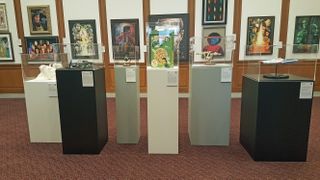
Three-dimensional sculptures are surrounded by 2D works of art in the "Star Trek: 50 Artists. 50 Years" gallery.
Several Styles of "Star Trek" Art

Artwork at the "Star Trek: 50 Artists. 50 Years" gallery came in many different shapes, sizes, textures and styles. Many artists re-created the retro look of the 1960s, when "Star Trek" was born.
"The Vulcan Salute"
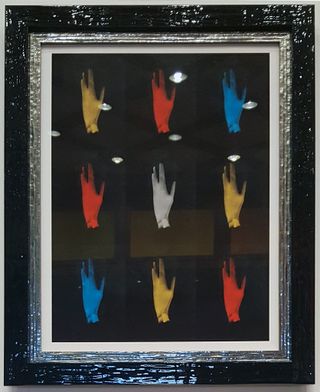
Leonard Nimoy, the actor who played Spock, created this piece using photographs of the famous Vulcan hand salute. Nimoy passed away on Feb. 27, 2015, but his artwork still made it to the "Star Trek: 50 Artists. 50 Years" gallery this fall. (Note: This photo contains a glare/reflection from the glass in the art gallery. See a clearer digital image here .)
"They're Dead, Jim"
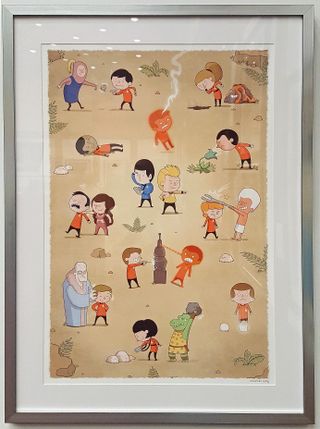
Austrian artist Anna-Maria Jung grew up watching "Star Trek." She created this cartoon, titled "They're Dead, Jim," which shows the brutal deaths of "Redshirt" characters in a comical light.
"Home Is Where the Journey Is"
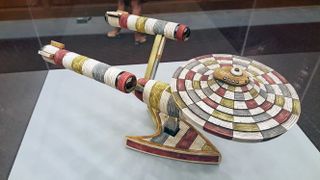
This ceramic model of the USS Enterprise was hand-sculpted by Calvin Ma, an award-winning artist from San Francisco.
"Strange New Worlds"
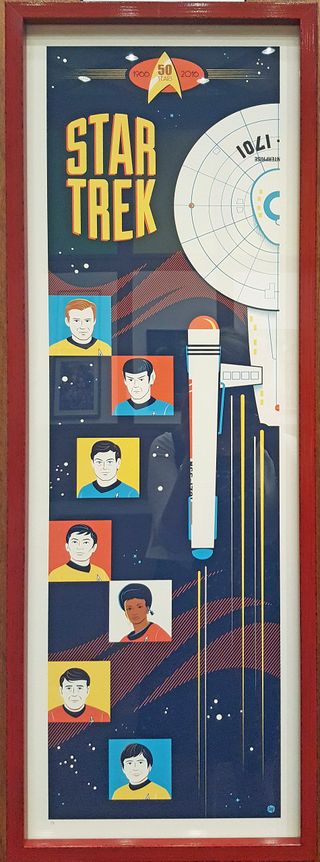
Caption: This illustration of the USS Enterprise is by Dave Perillo, an American cartoonist who has created art for Marvel and Disney. "I wanted this piece to reflect that era of design since the show debuted in the mid-60s," Perillo said.
"Strangely Drawn to It"

In this illustration by Dave Quiggle, Spock holds a black cat on his lap — but not just any cat. This is actually a shape-shifting feline from the original series by the name of Isis. She can also appear as a human female.
"Fifty Aliens"
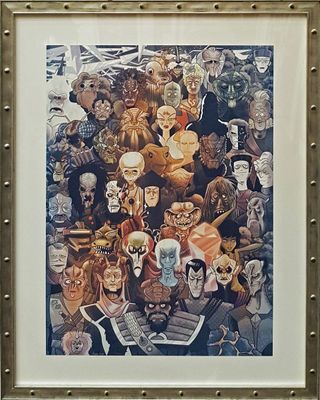
In honor of "Star Trek's" 50th anniversary, comic book artist Derek Charm chose to illustrate 50 aliens from the various "Star Trek" series. "I wanted each of these representatives to be more or less presented with equal importance and highlight the diversity found in this universe full of all kinds of life," said Charm .
Join our Space Forums to keep talking space on the latest missions, night sky and more! And if you have a news tip, correction or comment, let us know at: [email protected].
Current page: Page 1
Get the Space.com Newsletter
Breaking space news, the latest updates on rocket launches, skywatching events and more!

Hanneke Weitering is a multimedia journalist in the Pacific Northwest reporting on the future of aviation at FutureFlight.aero and Aviation International News and was previously the Editor for Spaceflight and Astronomy news here at Space.com. As an editor with over 10 years of experience in science journalism she has previously written for Scholastic Classroom Magazines, MedPage Today and The Joint Institute for Computational Sciences at Oak Ridge National Laboratory. After studying physics at the University of Tennessee in her hometown of Knoxville, she earned her graduate degree in Science, Health and Environmental Reporting (SHERP) from New York University. Hanneke joined the Space.com team in 2016 as a staff writer and producer, covering topics including spaceflight and astronomy. She currently lives in Seattle, home of the Space Needle, with her cat and two snakes. In her spare time, Hanneke enjoys exploring the Rocky Mountains, basking in nature and looking for dark skies to gaze at the cosmos.
Dune: What the climate of Arrakis can tell us about the hunt for habitable exoplanets
This Week In Space podcast: Episode 104 — The Artemis Accords, Ecuador, and You
SpaceX Falcon Heavy rocket photobombs the moon in incredible award-winning shot

Most Popular
By All About Space magazine May 28, 2023
By Fran Ruiz May 06, 2023
- 2 Jedi Masters battle space pirates in new 'Star Wars' novel 'The Living Force' (exclusive excerpt)
- 3 James Webb Space Telescope joins the hunt for newborn exoplanets
- 4 The 2024 total solar eclipse is 1 week away. Here's what you need to know.
- 5 Pluto TV will rally to make Pluto a planet again on April 1 (it's no joke)
- More to Explore
- Series & Movies
Published Feb 27, 2024
First Look at Star Trek: Picard: The Art and Making of the Series
Everywhere books are sold now!

StarTrek.com
From Joe Fordham, get an inside look behind Star Trek: Picard , with the release of Star Trek: Picard: The Art and Making of the Series — a must-have for all Star Trek fans.
This beautifully illustrated hardback, available now everywhere books are sold , features behind-the-scenes and on-set photography, and a range of production art, is an in-depth exploration of a hugely popular and seminal Star Trek character.
Alongside interviews with showrunners, writers, cast, and crew, discussing concepts and character arcs, "Spotlight" features explore makeup, costumes, art, and visual effects. A final section features reflections on the much-beloved character from its original incarnation in Star Trek: Next Generation through to its final satisfying conclusion.
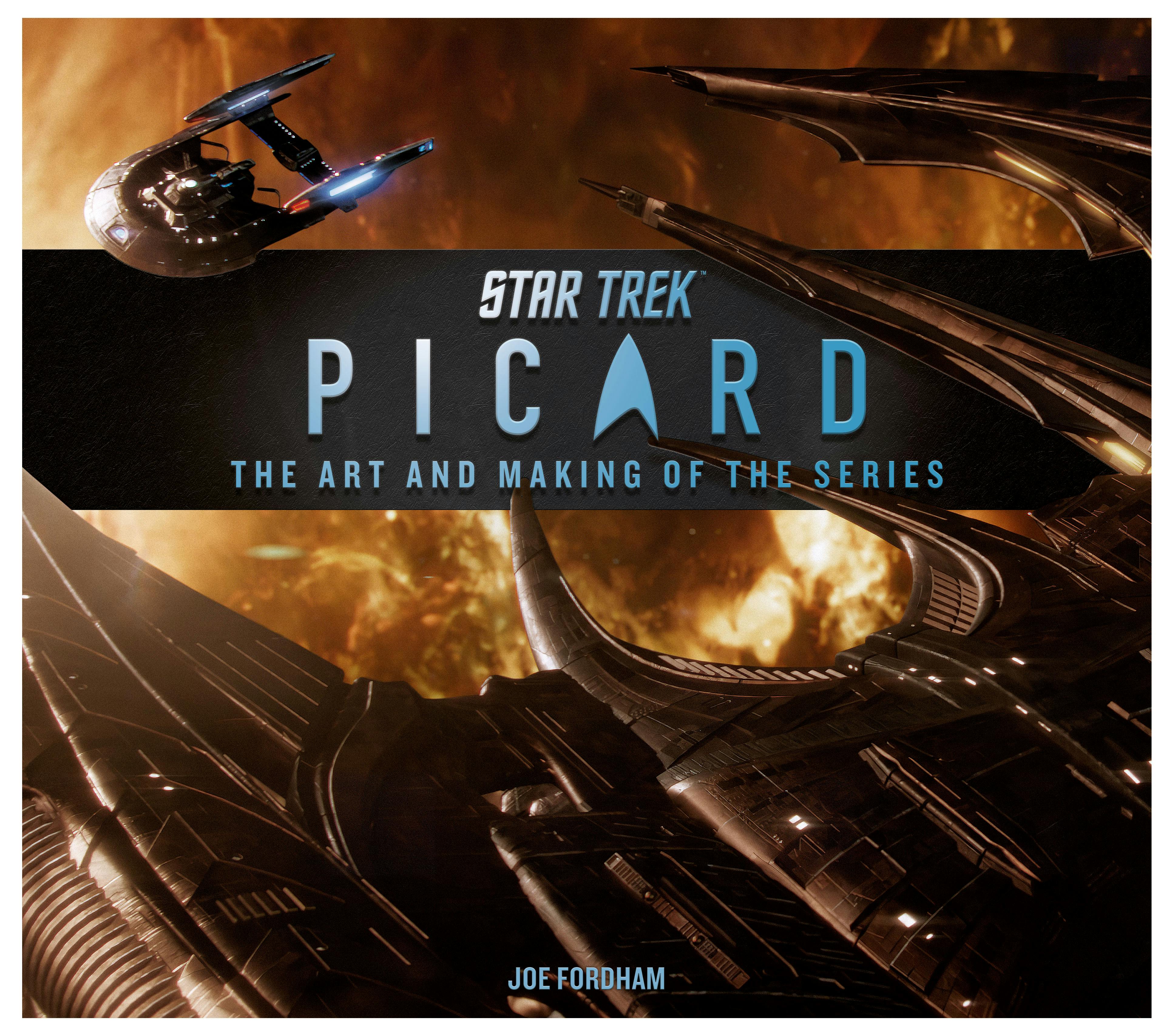
Star Trek: Picard stars Patrick Stewart, reprising his role as Jean-Luc Picard from Star Trek: The Next Generation . The book explores each of the three separate season-long narratives, which tell the story of Picard in later years, as he is brought out of retirement on his family château to face old enemies such as the Borg, take command of a new starship, and ultimately reconcile with his past.
New characters such as Raffi Musiker (Michelle Hurd), Dr. Jurati (Alison Pill), Cristóbal Rios (Santiago Cabrera), Soji (Isa Briones) and Elnor (Evan Evagora) feature alongside appearances by old enemies and friends, such as Will Riker (Jonathan Frakes), Deanna Troi (Marina Sirtis), the Borg Queen (Annie Wersching), Guinan (Whoopi Goldberg, Ito Aghayere), Data (Brent Spiner), and Q (John de Lancie). Season 3 sees a full-scale Next Generation reunion, featuring Worf (Michael Dorn), Dr. Beverley Crusher (Gates McFadden), and Geordi La Forge (LeVar Burton).
Thanks to our friends over at Titan Books, StarTrek.com has an inside look at Star Trek: Picard: The Art and Making of the Series!
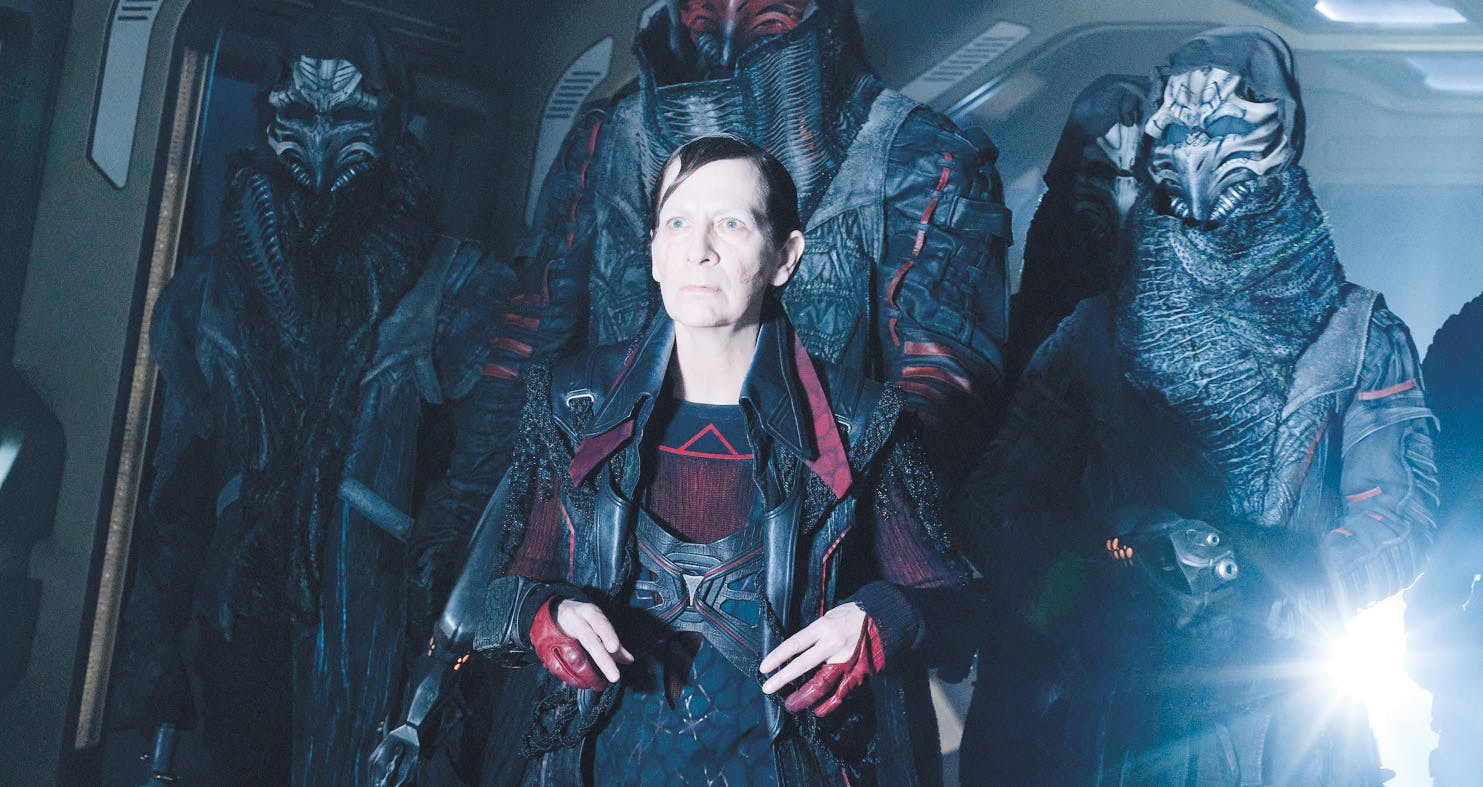
VADIC CHANGELING AVENGER
The Shrike captain announces herself as Vadic (Amanda Plummer), leader of a rogue faction of Changelings, liquid-based shapeshifters from the Gamma Quadrant. "Amanda Plummer was the only person I ever thought of for this role," states Terry Matalas. "Early on, I didn’t know that she would do it. I knew that Amanda had Star Trek lineage as her father, Christopher Plummer, played General Chang in Star Trek VI: The Undiscovered Country .
To our delight, she said ‘yes’ and she brought so much to the character. She made Vadic one of the great Star Trek villains."

Vadic’s tortured history sprang from a clandestine operation, an offshoot of the Dominion War against the Federation. "They were held captive on Daystrom Station by a nefarious group within Starfleet, Section 31," Matalas explains. "They were trying to make Changelings that were undetectable down to an organ level in a way that Changelings had not been before. Vadic and her people escaped from that lab with their new abilities, and they found a like-minded dying species, the Borg, who teamed up with them to put an end to Starfleet once and for all."
The makeup team explored designs for Vadic and her Changelings that acknowledged their genetic origins, as seen in Deep Space Nine ’s amorphous shapeshifting security chief Odo (René Auberjonois), with a twist. "We tried a variety of prosthetic designs for Vadic," recalls Vincent Van Dyke. "We ended up creating scars as a design element on her face. They were quite symmetrical, even beautiful. The idea was these were scars that had injured her, symmetrically, on each side of her body. Technically, they were quite simple for us to create, not extensive makeup. But what a wonderful actress."
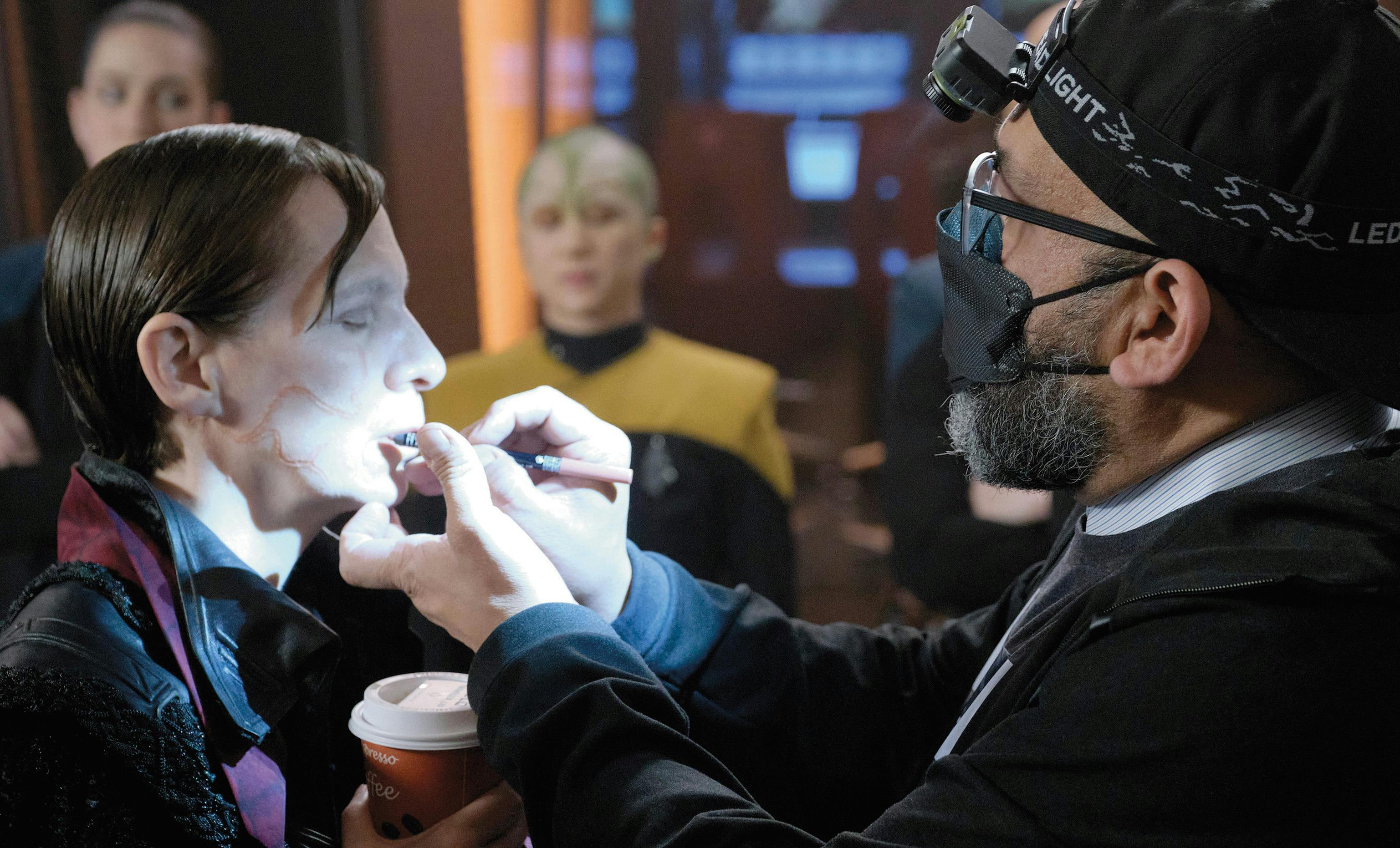
"Amanda was fantastic," concurs James MacKinnon. "Talking to her about what we were going to do, she was very particular, and quiet. But when she started talking about how she was going to play the part, it was awesome to watch. We ended up taking the color out of her eyebrows. We gave her a pale face and some cheek scars as silicone transfers. The idea was that, as a Changeling, she’d been partway through forming into another character when she stopped and that left subtle scarring on her face. We gave those scars a natural lip color."
"Changelings loyal to Vadic carry disruptor weapons illicitly acquired on their travels through the Delta Quadrant. Vadic brandished a femme-fatale-style smoking device. "Terry and Amanda wanted her to be wreathed in smoke sitting on her bridge," recalls Jeff Lombardi. "We’ve not seen many aliens smoking cigarettes before in Star Trek . Amanda does smoke, which helped. We got her blend that she was comfortable with, and we designed an alien cigarette holder and different papers. It was a simple device, the end of the holder held a rolled joint and the two melded together as a smoking apparatus. We also gave her some old French lighters and a Romulan knife — one of the Reman blades that Picard’s clone, Shinzon, had used in Star Trek Nemesis ."

Go behind-the-series with Star Trek: Picard: The Art and Making of the Series , on-sale now!
Get updates by email.
In addition to streaming on Paramount+ , Star Trek: Picard also streams on Prime Video outside of the U.S. and Canada, and in Canada can be seen on Bell Media's CTV Sci-Fi Channel and streams on Crave. Star Trek: Picard is distributed by Paramount Global Content Distribution.
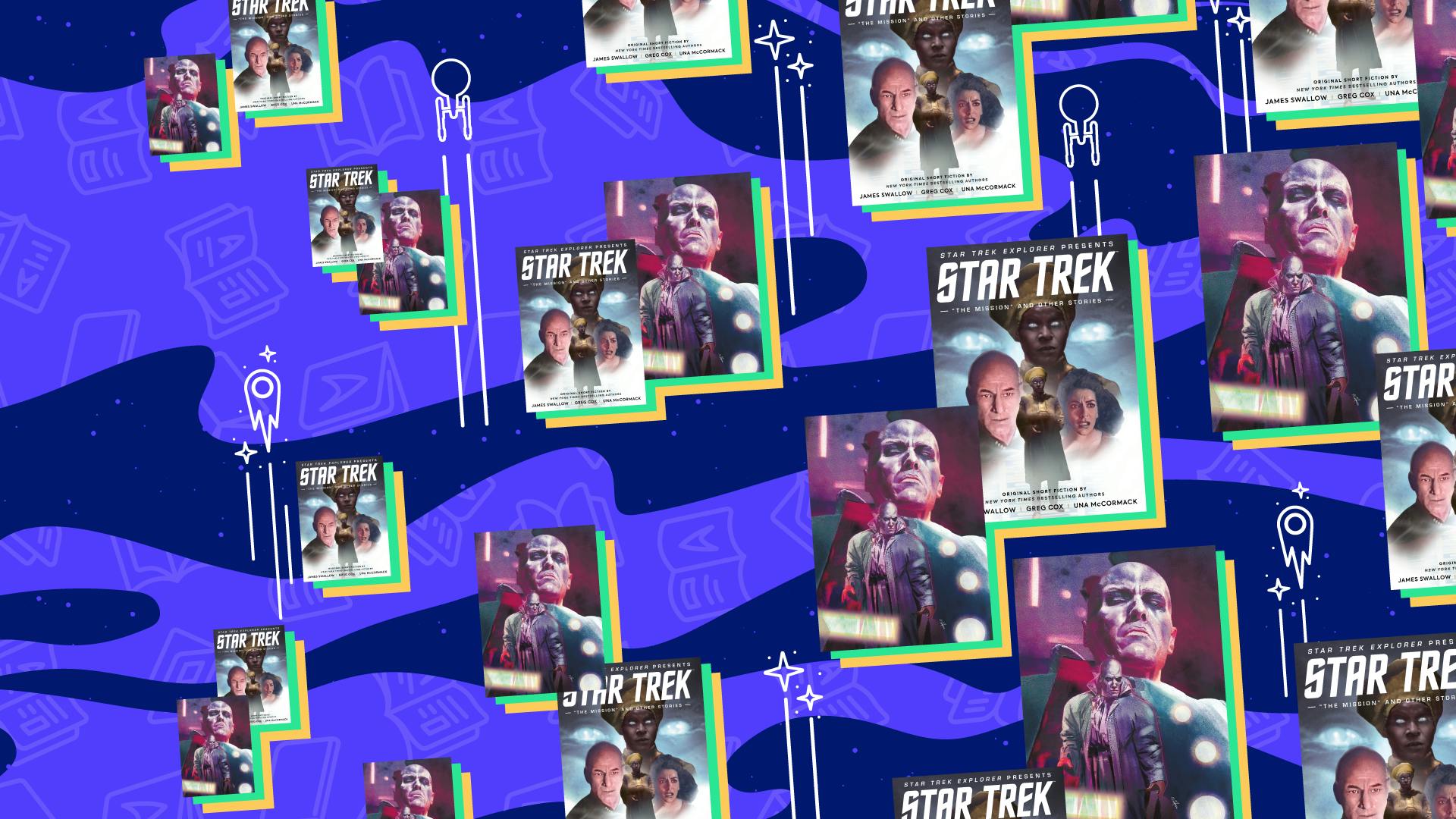
Universe Watcher
Discover what exist in the universe
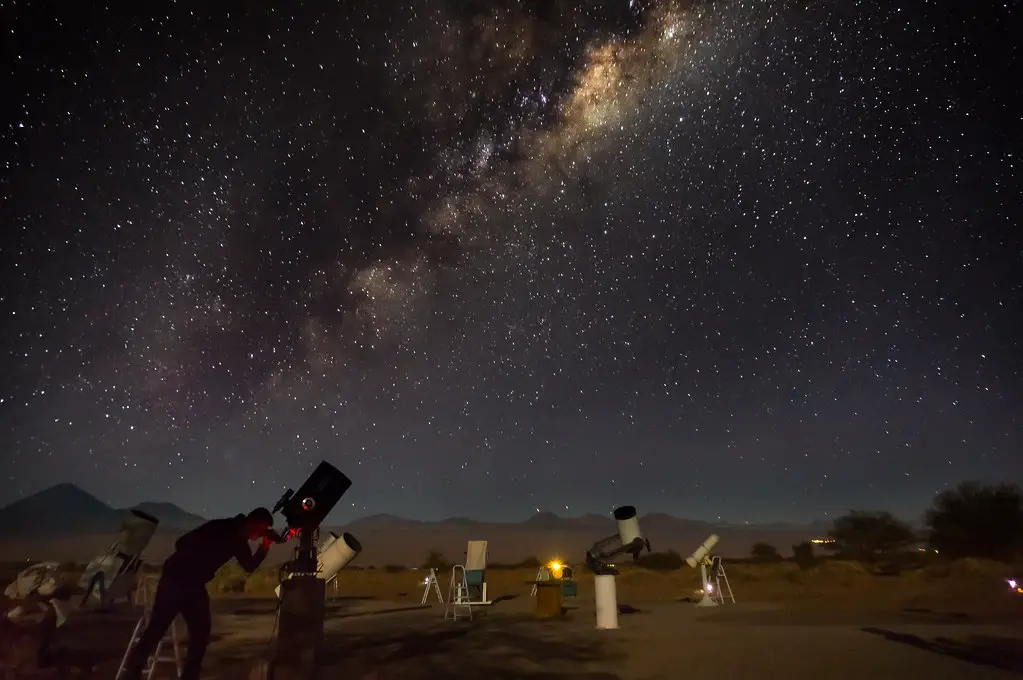
The Art and Meaning of Sky Gazing
Sky gazing, sometimes called star gazing or sky viewing, is a fascinating activity that involves examining the celestial bodies and taking in the sky’s breathtaking splendor. From prehistoric astronomers with crude telescopes to contemporary space aficionados with cutting-edge gear, people have been engrossed in the fascinating activity of stargazing throughout recorded history. It is an incredibly meaningful method to establish a bond with the enormous cosmos and reflect on our place in its breathtaking emptiness. Gazing up at the sky gives us the opportunity to explore the depths of cosmic wonders, lose ourselves in the glories of galaxies , constellations, and nebulae, and reflect on the countless mysteries that lie overhead. This captivating journey allows us to become a part of the cosmic tapestry, where the sky’s beauty serves as a gateway to deep reflection and a sobering reminder of how big the world is.
Understanding Sky Gazing
There’s more to skygazing than simply raising your gaze to the stars. This is a task that requires in-depth thought and contemplation. Whether it is day or night, when we stare up at the sky, we are effectively peering into an endless void that exists outside of our physical reality. This can make us feel humble, amazed, and awed as it serves as a reminder of how tiny we are in the scheme of things.
Looking up, our eyes follow the celestial tapestry, identifying constellations that have provided centuries of guidance to storytellers and mariners. Like far-off lights, the sparkling stars invite us to explore the uncharted and discover the mysteries of the universe.
During the day, fluffy white clouds float languidly across the horizon, revealing a vivid palette of blues in the sky. A feeling of peace and tranquility is evoked by the way that every passing cloud appears to create a different picture in the sky. Millions of stars cover the velvet canvas in the night sky, creating an amazing spectacle. The Milky Way spans the distance, a celestial river of stardust that serves as a constant reminder of the size of the cosmos and the innumerable worlds that might be out there.
Stargazing is more than just a hobby—it’s a doorway to creativity and reflection. It enables us to re-establish our connection with the wonders of the cosmos and break out of the clutter of daily life. We find comfort, inspiration, and a fresh appreciation for the beauty all around us during those times of reflection.
Now, just take a moment to raise your gaze, let your thoughts wander among the stars, and lose yourself in the expanse of the sky. All it takes to begin exploring the universe is to cast a glance above.
The History of Sky Gazing
The thousands-year-old tradition of stargazing includes many facets of the lives of ancient cultures. They would frequently look up at the sky, using the positions and motions of celestial bodies as a source of direction. This celestial sight improved their ability to navigate the oceans and manage agricultural cycles, which also stoked their desire to predict upcoming events.
Astrology is a belief system that has its roots in sky gazing and proposes a significant connection between the positions of celestial bodies and human lives. People have been enthralled by this age-old technique for generations. One of the most well-known prehistoric structures in the world, Stonehenge, is evidence of our ancestors’ preoccupation with the sky. It is thought that this amazing construction, with its thoughtfully placed stones, functioned as an early astronomical observatory, enabling astronomers to learn more about the wonders of space.
There is more to ancient civilizations and the universe than meets the eye. They created complex mythology, linking the activities of gods and goddesses to the motions of celestial bodies. It was thought that these celestial creatures shaped destinies and offered wisdom about the unknown, impacting human lives.
Moreover, astrology was not the only field in which celestial bodies were studied. Ancient astronomers carefully monitored the sun, moon , planets, and stars to aid in the development of early calendars and navigational systems. Their deep knowledge of astronomical patterns enabled them to more precisely sail large oceans and choose the best times to grow and harvest crops.
There is no denying the importance of stargazing in ancient societies. It was a source of inspiration and amazement in addition to being a useful tool. With its innumerable sparkling stars, the night sky has long served as a blank canvas for human creativity, inspiring curiosity about and a drive to solve the universe’s riddles.
In summary, sky gazing has had a significant influence on how ancient civilizations have lived. Looking up at the sky has had a profound impact on human history, inspiring myths, directing agricultural methods, and igniting curiosity that led to scientific breakthroughs.
Modern Sky Gazing
Even among ardent amateurs and expert astronomers today, sky gazing is a captivating pastime. We have the incredible capacity to see into the depths of the universe and discover a world of wonder and awe because of the amazing developments in telescopes and digital technologies.
By using these potent tools, we may investigate the secrets of far-off galaxies, revealing their complex structures and striking astronomical events. Nebulae are celestial clouds made of gas and dust that captivate us with their cosmic dance by revealing their magnificent colors and ethereal beauty. However, stargazing goes beyond what science has discovered. In the context of mindfulness and meditation, it has a special position since it provides a means of establishing a connection with the expanse of the sky and discovering inner peace. When we look up, the vastness of the sky beckons us to slow down our rushing minds and let a sense of calm and peace fill our hearts.
Some people find comfort and perspective in the night sky sanctuary. The infinite space overhead acts as a subtle reminder of our place in the universe, placing our concerns and personal issues in a larger perspective. Gazing up at the sky can be a healing practice for the anxious mind, calming our emotions and relieving tension and worry.
Thus, let’s enjoy the fascinating realm of stargazing, where spirituality and science collide. Let’s take in the wonder of the cosmos and, in the process, realize how deeply we are connected to both it and ourselves.
The Spiritual Significance of Sky Gazing
The practice of stargazing is a profound and captivating experience from a spiritual standpoint. The sky has a special place in many cultures and religions, and it’s frequently associated with mystical or divine qualities. For example, sky gazing is a highly effective meditation method used in Buddhism that enables people to develop a deep sense of expansiveness in their thoughts. One can easily remove the illusion of separateness and fully embrace the oneness of all beings by submerging oneself in the limitless beauty of the sky. By means of this astounding exercise, one can achieve a profound sense of oneness with the cosmos, surpassing the confines of the material world and establishing a connection with the boundless energy that envelops us.
To sum up, stargazing is more than just a recreational activity or an academic pursuit. It allows us to feel amazement and wonder, contemplate our existence, and establish a connection with the universe. Stargazing may be a singular and meaningful experience, regardless of whether you are an ardent astronomer or just seeking some quiet time.
- International edition
- Australia edition
- Europe edition
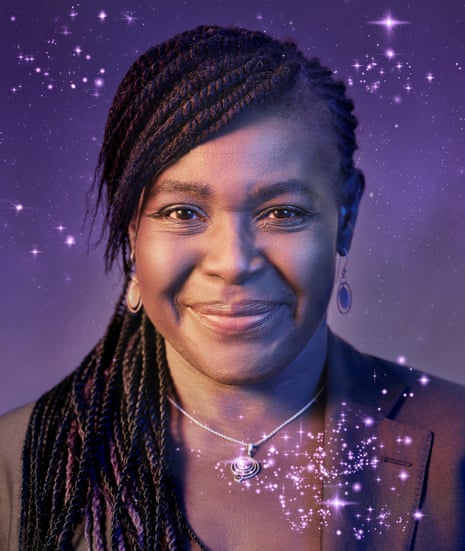
‘Call me chief priestess for the moon goddess’: space scientist Dr Maggie Aderin-Pocock
The Sky at Night presenter’s boundless enthusiasm has been lighting up our TV screens for years. Here, Dr Maggie Aderin-Pocock talks about taking over from Sir Patrick Moore, building her first telescope – and why she wants us all to look up at the night sky
C all me chief priestess for the moon goddess,” says Dr Maggie Aderin-Pocock when I ask whether she prefers to be known as an astronomer, physicist or space scientist. She is, after all, entitled to all of them because before presenting The Sky at Night on the BBC she trained as a physicist, then an engineer and is now the nation’s go-to woman for all things space. But it seems that she really has her eye on the job of a 4,300-year-old Sumerian religious leader.
“I was giving a talk in the Scottish parliament,” she explains when we meet at a photographer’s studio hidden in a blink-and-you’ll-miss-it alleyway in east London, “and I mentioned En Hedu’anna, the first female scientist who was known as chief priestess for the moon goddess of the city of Ur [in ancient Mesopotamia].” After the talk, the chair suggested they vote to bestow on Aderin-Pocock the title of chief priestess for the moon goddess of the city of Edinburgh. “That’s what I would like on my business card,” she says with a delighted clap of the hands and the kind of irresistible enthusiasm that viewers of The Sky at Night will be familiar with.
Forgotten or uncredited scientists, such as En Hedu’anna, feature prominently in Aderin-Pocock’s new book, The Art of Stargazing , a practical guide to identifying and understanding the 88 constellations. She is also keen for us to look at these familiar formations through non- western eyes. We are accustomed to a version of the celestial map that was charted and tagged, she says, “by white men in togas”, but many people in cultures and civilisations outside Ancient Greece and Rome have done this thing of looking up and saying, “Doesn’t that patch of stars look a bit like our dog?”

But these days, when the James Webb Space Telescope is peering back in time to the birth of entire galaxies and we can photograph black holes, why are we still fascinated by something so low-tech as drawing pictures in the night sky? “People take the sky for granted, they don’t look up enough,” she says, “and the thing is, astronomy is a science, but it’s a science that anyone can do: anyone can look up and think, what’s that? It’s something we should get back to.”
Looking up was something Aderin-Pocock, 55, did a lot with her husband and 14-year-old daughter at their Surrey home during the first lockdown. Each would do their own thing during the day, but at night they would get together and look up at the stars. “It put things into perspective and made everything feel less oppressive.”
And so the idea of getting back to astronomy basics was born, and she was soon researching the history of the constellations and the forgotten science of ancient cultures – something that wasn’t as hard as you’d think. “There’s actually a whole area of study called archaeoastronomy. All these cultures have been looking at the stars and trying to understand them for thousands of years – and that mustn’t be forgotten.”
But why is outdated ancient science from long-dead civilisations still important? “When I grew up, there were many kids who looked at science and thought: ‘Well, someone like me doesn’t do that because it’s not my culture, it’s not for me – I don’t have a history of this.’ Diversity is about bringing different ideas and people into science because if it’s all just done by the European white guys, we get a very blinkered view of the world. That’s why access to the history of astronomy is important for everyone.”
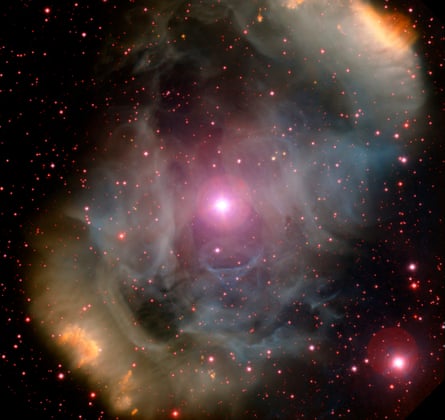
Is the world of science getting better at diversity? “I think it is, but things need to move faster. There are still the dinosaurs who are all, ‘Women don’t do science! What are you talking about?’ But I also think those dinosaurs are dying out and there is opportunity – and that’s where I’ve been quite lucky being black and female – with the timing.”
And also qualified, I point out: “Yes! I love the subject and I’ve worked hard at it so I don’t think I’ve been given anything I didn’t deserve, but I think my voice has been louder because of the demographic I come from.”
Aderin-Pocock, who is dyslexic, grew up in a block of council flats in Camden, north London. Her parents divorced when she was a child – her mum was a youth worker and magistrate, and her dad had been a teacher in Nigeria and ran an import/export business in the UK. Young Maggie’s interest in the stars was sparked in childhood by TV shows such as The Clangers and Doctor Who . She was also a fan of The Sky at Night with Sir Patrick Moore , the grandfather of astronomy popularisation, and her route into science began when she bought a not-very-good telescope because, “I wanted to be able to see the things that Patrick was talking about on television.”
But the telescope didn’t work. It was then that she saw an ad for a make-your-own-telescope evening class at a local school. She went along, but there was a surprise waiting for her. “I remember opening the door and walking in and the average age was 50, and they were all white guys!”

Did she feel intimidated? “No, I wasn’t unwelcome at all, because we all had a common goal. It was just an ‘I-am-not-like-the-other-guys-in-this-room moment.’ For me, making a telescope was a means to an end. I just wanted to get closer to what was out there – I actually wanted to go out to space myself, but that wasn’t possible, so the next best thing was to build instruments that could get me closer.”
Aderin-Pocock says she owes a lot to that homemade telescope. “I still have it. When I went to university, I used it for my undergraduate project. Working on that telescope got me into optics, which got me into instrumentation and gave me my career.”
It’s a career that saw her graduate from Imperial College London with a PhD in 1994 and includes work on satellite surveys of ship movements in Singapore and studies of climate change (“70% of the work I’ve done has been ground-based with satellites looking at Earth to help us down here”). In 1996, she began work with a branch of the Ministry of Defence on landmine detection and missile warning systems. She returned to Imperial in 1999 to join a project that was developing a spectrograph for the Gemini South telescope in Chile, and that was her launchpad into space science. But it is her work on The Sky at Night that she is best known for.
The show had been presented by Patrick Moore for 56 years until his death in 2012 and he was part of the national fabric, so when Aderin-Pocock was approached to join the presenting team after he died, she was a little apprehensive. “I was so keen, because that’s part of my childhood. But I was also nervous, because he was such an icon.” (Although she had been on the programme a couple of times before joining in 2014, she never met him.)
The offer to co-present alongside Chris Lintott, Pete Lawrence and Lucie Green – the team at the time – also brought out those harrumphing dinosaurs of science. “Some people were a bit, ‘Oh, it’s the BBC being politically correct,’ but by then I’d gone out speaking to thousands of kids and done lots of science communication so I was well qualified, but they saw a Black woman doing a job and thought, ‘Well, yeah, it’s PC.’”
Nine years on, the programme, one of the longest-running TV shows in the world, is still going strong – even if the number of episodes in each series keeps being reduced (yes, we notice, BBC). “And it’s so much fun. Sometimes when I interview someone, I go, ‘Really? You can do that now?’ because there’s so much astronomy going on that’s pushing the science of the impossible. Some of the things that when I was at university we’d only dream of, we’re doing them now.”
But such enthusiasm for astronomy isn’t always universal: the criticism sometimes levelled is that it’s all a little esoteric. What’s the use of knowing there’s a black hole at the centre of our galaxy? It’s an attitude she is familiar with. “When I told my dad I wanted to do physics he was a little perturbed. He thought I should go into medicine, because that was what minority kids did – law, medicine, the set goals. But with physics you can’t see a set path for it. And then later, when I’d appear on Newsnight , Jeremy Paxman would be all, ‘So you’re doing this – but what’s the point?’
“The thing is, people don’t say that about poetry and art. They enhance the soul. I think that’s hard to argue with, but on top of that astronomy does so much more. It pushes the limits of our technology. When you develop something for a space telescope, you can use it on the ground. So it’s not a standalone thing that has no impact on human beings. It enhances our knowledge and tells us our place in the universe. But also develops so much of our tech, too.”

When I ask if she ever gets bored with all the wonder, she tells me about leading the team that installed the spectrograph she helped develop at Imperial College on the Gemini telescope in the Chilean Andes. “It’s on top of a mountain and I was out there for six months, and every night I’d sit and have a glass of the local Chilean wine and I’d toast the moon and look at the sky. And I thought that, after a while, I might get bored of it. But I couldn’t help it, I was out there every night, because it was just so glorious and I think it draws us to it, we wonder what lies beyond. And I wonder, if we lived on a planet with a thick atmosphere like Venus that obscures the stars all the time, would we be different?”
Yet at the same time as she was heading up prestigious projects such as the Gemini telescope, she was facing a constant battle to fill scientific posts: “I wasn’t getting enough applications for jobs I was advertising.”
It was something she had seen the signs of for a while. “I called it the dinner party test: you’re sitting next to someone at a dinner party and they say what do you do? And you say ‘scientist’ and then watch the horror on their face. But when I started to tell them exactly what I do, they were fascinated, almost as if they didn’t think science could be fascinating.”
Faced with a challenge, she decided to do something about it and set up a company, Science Innovation, with the aim of reaching out to convert the public to the joys of science. “I thought, I have to go out and sell Stem [science, technology, engineering and maths] to people, especially to the kids, and show them it makes a difference to our lives.”

Aderin-Pocock’s now been going into schools and speaking at conferences for 19 years and estimates she has spoken to 500,000 people – mainly schoolchildren. “I do see the enthusiasm in kids’ eyes. They see things differently, they don’t have the limitations of adults. They’ll say ‘Why?’ to everything. To me, that’s what it means to be a scientist: asking, why?”
One of the questions she likes to ask children is, would you be terrified or excited if we found aliens? (She always puts her hand up for both options.) “I do believe there is life out there, because it’s a numbers game. There are billions of stars in our galaxy and there are 200bn galaxies so why would life just be here? But what form that life would take, I don’t know.”
Talk of alien life leads inevitably to UFOs and conspiracy theories – so does she think governments are keeping things from us? “I’m less inclined to believe in alien abduction and things like that because of the distances involved. Also, one of the major factors is, do civilisations overlap? I say to kids, imagine the aliens landing and stepping out on Earth to find… dinosaurs, because our civilisations don’t overlap. There’s lots of things that would work against us in terms of finding aliens, but I still believe they’re out there.”
The Sky at Night has been going for 66 years and during that time so much has happened in the world of astronomy. What would she like to see happen in the next 66 years? She claps her hands and the enthusiasm ramps up another notch. (If you’re a Sky at Night fan, be assured, her joy for the subject is boundless. I once interviewed Patrick Moore and had a sense of standing before a fire hose of knowledge and enthusiasm – there was no need to utter a single question. Aderin-Pocock has a similar touch and fervour.) “One of my fond memories of looking through the archive, is Patrick saying things like, ‘When we meet the Martians’, because at the time we thought there would be Martians. So, the evolution of ideas since then is fantastic, and what excites me the most right now are exoplanets, planets around other stars.”

I could talk space with Aderin-Pocock all day, and she is only just getting started – drilling down into the prospects of sending probes to those exoplanets that so engage her, or how we might communicate with aliens if we discover them – but more down-to-Earth concerns interrupt as her daughter is in need of picking up.
One final question: building satellites and telescopes, educating the nation on the complexities of the universe, and taking Stem to thousands of school kids – she seems to do it all with such ease, is there anything that the chief priestess for the moon goddess finds hard?
“Writing a book with dyslexia!” she shoots back immediately. Then, almost as if she feels bad for dissing her dyslexia, she adds: “It has steered my career to places where I can excel better – but my worst-case scenario is to be given a speech and have to read it out. Just talking about things I know is no problem, I love that. Shutting me up is the key.”
The Art of Stargazing, My Essential Guide to Navigating the Night Sky by Dr Maggie Aderin-Pocock is published by BBC Books on 2 November at £16.99. Buy it for £14.95 at guardianbookshop.com
- The Observer
Most viewed

IMAGES
COMMENTS
From Joe Fordham, get an inside look behind Star Trek: Picard, with the release of Star Trek: Picard: The Art and Making of the Series — a must-have for all Star Trek fans. This beautifully illustrated hardback, available now everywhere books are sold, features behind-the-scenes and on-set photography, and a range of production art, is an in ...
The Art and Meaning of Sky Gazing. Sky gazing, sometimes called star gazing or sky viewing, is a fascinating activity that involves examining the celestial bodies and taking in the sky’s breathtaking splendor. From prehistoric astronomers with crude telescopes to contemporary space aficionados with cutting-edge gear, people have been ...
The Art of Stargazing, My Essential Guide to Navigating the Night Sky by Dr Maggie Aderin-Pocock is published by BBC Books on 2 November at £16.99. Buy it for £14.95 at guardianbookshop.com.